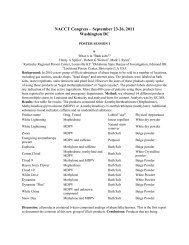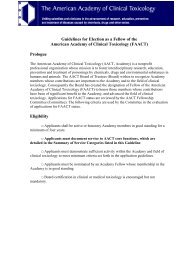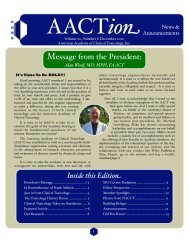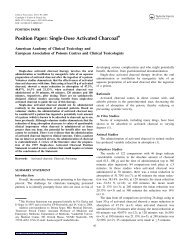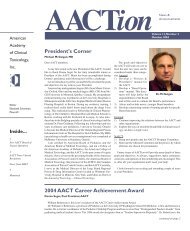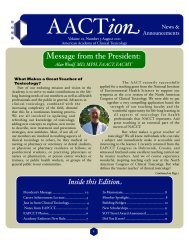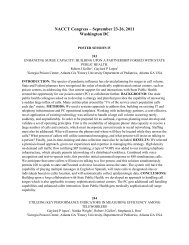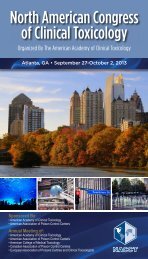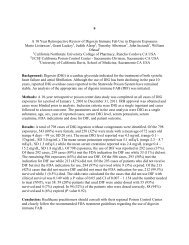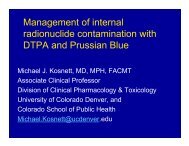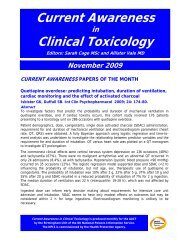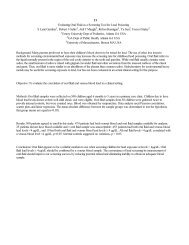NACCT Platform Abstracts 2012 - The American Academy of Clinical ...
NACCT Platform Abstracts 2012 - The American Academy of Clinical ...
NACCT Platform Abstracts 2012 - The American Academy of Clinical ...
You also want an ePaper? Increase the reach of your titles
YUMPU automatically turns print PDFs into web optimized ePapers that Google loves.
160<br />
Comparison <strong>of</strong> exposure fatalities from the medical examiner's <strong>of</strong>fice and the poison center<br />
Suzanne Doyon 1 , David Fowler 2<br />
1 University <strong>of</strong> Maryland School <strong>of</strong> Pharmacy Maryland Poison Center, Baltimore MD USA<br />
2 Office <strong>of</strong> the Chief Medical Examiner, Baltimore MD USA<br />
Introduction: <strong>The</strong> Office <strong>of</strong> the Chief Medical Examiner (OCME) play a critical role in investigating exposure deaths. In<br />
2010, a collaboration between the OCME and the Maryland Poison Center was started. <strong>The</strong> type <strong>of</strong> fatal exposure most<br />
likely to be reported to the poison center has not been studied.<br />
Purpose: Determine and characterize the exposure deaths investigated by the OCME and reported and not reported to the<br />
poison center.<br />
Methodology: A query <strong>of</strong> the OCME database from January 1 2011 to December 31 2011 (12 months) was performed<br />
using query words that would identify all exposures fatalities. Demographic information including all zip codes, site <strong>of</strong> death,<br />
cause <strong>of</strong> death, manner <strong>of</strong> death, complete toxicologic analysis and field notes were obtained.<br />
Results: A total <strong>of</strong> 810 poisoning fatalities were examined over a 12-month period. Four hundred ninety (61%) died prehospital;<br />
320 (39%) died in hospital. Of these, 229 died in the emergency department (ED) after presenting in cardiac arrest<br />
without return <strong>of</strong> spontaneous circulation and 91 died after being admitted to the hospital. Comparison <strong>of</strong> the 91 hospitalized<br />
exposure deaths is found in Table 1. Twenty six deaths were captured and 65 were not captured by the poison center. <strong>The</strong>re<br />
were 5 hospitalized fatalities in children under 18 years <strong>of</strong> age. <strong>The</strong> poison center captured 3 but did not capture one 13 yo<br />
burn victim and one 17 yo heroin overdose.<br />
Table 1. Hospitalized exposure deaths captured and not captured by the poison center.<br />
Reason for<br />
exposure<br />
Captured cases<br />
n=26 (%)<br />
Noncaptured cases and causes <strong>of</strong> death n=65 (%)<br />
Suicide 9 (60) 6 (40): carisoprodol 1; DoA 3; metoprolol 1; APAP 1<br />
Misuse/abuse 9 (18)<br />
Unknown 4 (33) 8 (66): DoA 7; phenytoin 1<br />
Adverse drug<br />
event<br />
2 (33) 4 (66)<br />
Environmental 0 4 (100): housefires 4<br />
Occupational 1 0<br />
<strong>The</strong>rapeutic<br />
error<br />
1 0<br />
Other 1 0<br />
DoA: Drugs <strong>of</strong> Abuse<br />
42 (82): DoA 18; liver failure 12; GI bleed 4; ICH 4; MI 2;sepsis<br />
2; pneumonia 2; others 7<br />
Discussion: Only 11% <strong>of</strong> exposures deaths investigated by the OCME were hospitalized before dying. <strong>The</strong>se would be the<br />
cases most likley to be reported to poison centers. Hospitals reported 60% <strong>of</strong> suicides. but only 18% <strong>of</strong> misuse/abuse resulting<br />
in death. Most <strong>of</strong> the misuse/abuse cases (57%) suffered from serious other life-threatening conditions (e.g. liver failure,<br />
bleeding,...) which may have influenced the reporting. Adverse drug events and environmental exposures were not frequently<br />
reported to the poison center. Hospitals that chronically underreported were identified.



